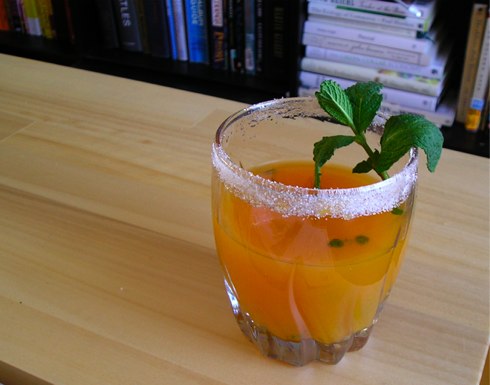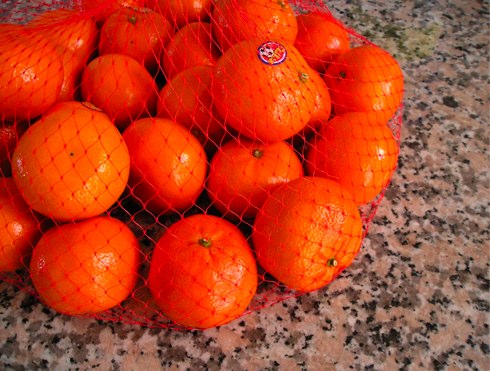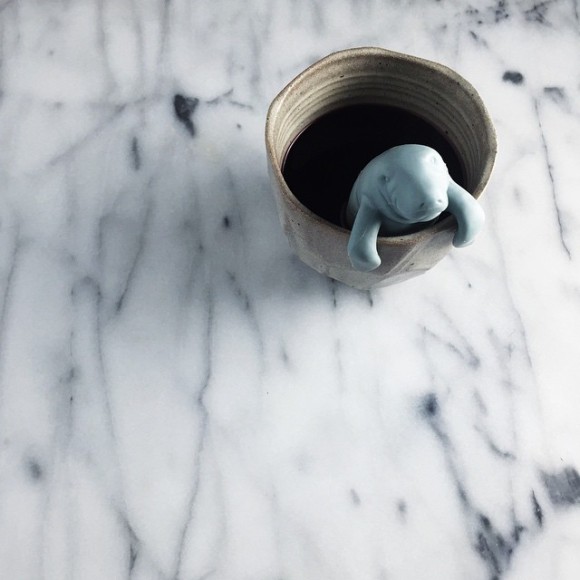by Sam Tackeff | Sep 14, 2010 | Gifts, Liquor, Mixed Drinks, Shopping

Scotch is classy.
Scotch is a man’s drink.
Scotch is, in fact, such a classy man’s drink that George Clooney is selling it to the Koreans.
I am neither a man, nor very classy (well, I do try sometimes). But, I love my liquor, and I feel a special kinship with Scotch Whisky that’s been years in the making.
My relationship with Scotch began, of all places, in a lab. A college geology lab, after dark, to be specific. In class we were learning about peat bogs, and someone decided to toast the 9,000 year old perfectly preserved peat bog man with some extra "peat-y" Scotch in his honor. And we may or may not have been taking part in this ritual while watching a Nova special about it at the time. It’s called "The Perfect Corpse" if you are curious.
 (Photo of the peat bog man: Lonely Planet Images)
(Photo of the peat bog man: Lonely Planet Images)
And, yes, I’m a nerd. But I kept good company, as a love of food and drink is typical of geologists, really scientists in general- in our lab we made good use of a cappuccino machine, and conversations that weren’t about albite twinning and plagioclase feldspar tended to be about our last meal, or perhaps our next one, or the one after that.
I’ve always found the link between science and food to run deep, even historically so – perhaps nothing will light a candle to the rumor that a defrosted Mammoth was served in the late 1800’s at a Royal Geological Society annual gathering. That, is food obsession at it’s best. (And no, I can’t substantiate that rumor, but I heard it once in a Paleo lecture.)

To the point:
When Victoria called us to schedule a Scotch tasting with Mark Stewart Cassidy at Omnivore, and promised me that a man in a kilt with a Scottish brogue would show up, be handsome, and teach us a little more about traditional Scotch whisky, I was a little beside myself. At the event, after drinking three generous samples of scotch, my feverish notes did become slightly less legible, but I’ve spent significant time deciphering them for the purposes of education about this finest of libations.
[For the record, Whisky = Scottish English, Whiskey = Irish English, and yes, I had to look it up.]
And so, for your entertainment, and mine, here I give 2 minutes for Scotch. This is by no means a thorough discussion, but perhaps a starting point for your own adventures. I digress.

Although Whisky has been made in Scotland for hundreds of years, Scotch became popular in part because of the Phylloxera bug wiping out the cognac and wine making production in France in the late 1800s. While drinking entire handles (do we call them handles?) of Scotch now seems to be a little excessive, to put it in perspective, Churchill was said to have drunk a bucket of brandy a day. What else would be better "after [a day of] shootin’ fishin’ or flogging peasants?"
What the heck is in this stuff, anyway?
Provided that the liquid is Made In Scotland some basic facts:
1. Essentially, Barley + Malt + Water = Scotch.
2. The cask to age the Scotch is always made of Oak. They usually are reused casks from making sherry or bourbon.
3. Evaporation occurs: The first year in the cask, 5% of the alcohol evaporates, and typically every year following an additional 2% evaporates. Some say because of this, the best value is at 10 years, (not necessarily the best taste), but at this point, it has aged, but not evaporated away.
4. Has to be at least 40% alcohol.
5. It is said that taste can be attributed 70% from the cask, 15% from the raw materials, and 15% from the production/skill of the distiller. That said, there is still mystery around what makes a perfect scotch. Every distillery has a master distiller, who’s entire job is to think about these things. There are stories about master distillers who "wouldn’t let anyone move cobwebs – [because] you don’t know what will effect the taste."

How to Taste Scotch:
1. Pour it: Leave whiskey in the glass for 1 minute for every year it has been in the cask.
2. Prepare it: Add a drop of water, down the side of the glass (as to not destroy the bouquet, and so the aroma stays intact). The water picks up the oils and helps to enhance aroma and flavor.
3. Think about it: when you drink scotch, take note of the nose, the body, and the finish.
There are five categories of Scotch: Single Malt, Blended Malt, Blended Scotch whisky, Blended Grain Whisky, and Single Grain Scotch Whisky. For this tasting, we sampled three varieties of Single Malt Scotch Whisky, each with their own distinct characteristics:

Scotch #1:
Highland Region, Aberfeldy 12 year ($39.50)
The first Scotch was the Aberfeldy, which I immediately enjoyed immensely because of the symbol on the bottle which appears to be a squirrel.
Aberfeldy is one of the distilleries that contributes to Dewars’, a particularly well known Scotch brand. Dewars was one of the first Scotch brands sold in a glass bottle with a label, and holds it’s own in the Scotch arena today –– In fact, about five blending houses own all the distilleries in Scotland.
Taking my first sip of the Scotch – HOO-AH – I had forgotten the kick this stuff can give! The bite goes away relatively quickly, the same way a properly spiced dish may give you an initial punch, and then settle down as to not torture you for hours.
During tasting we noted that there is no peat taste, because in the Highlands they mostly use coal to dry the barley. According to the master, there were also vanillins, traces of copper, and peroxide in the flavors.

Scotch #2:
Speyside Region, Benromach Organic ($85.00)
By far and away my favorite. This Scotch was unique because it was the worlds first certified Organic single malt. While Organics have taken their time to become a standard in the alcohol industry, the flavors of the highest quality ingredients grown in clean soil really make this Scotch stand out.
It was crisp and light, with a quick burn, and satisfying lingering sweet and spicy notes. And well, perhaps I’m just going crazy, but for some reason, I noted a hint of coconut which put me in a tropical mood.

Scotch #3:
Island Region, Highland Park 12 year ($45.00)
The final tasting was the Highland Park. Which evoked daydreams of sipping the stuff on the lawn of a big castle, playing cards, and smoking cigars. Maybe with Robin Williams in golf attire in the background.
Perhaps the most like what people traditionally think of when they think of Scotch, this was an example of Peat whiskey, given it’s distinctive taste of drying the barley over peat. ( I got to admit, everyone loved it, and I think it tastes like drinking from a bog. A pleasant bog, but bog none the less.)
In summary, who knew that my favorite would end up being the $85 dollar bottle that I can’t actually afford to plunk down the cash for? Well, if anyone would like to remedy that ––
Scotch available at:
The Whisky Shop | 360 Sutter Street | San Francisco |415.989.1030
The question becomes, where do I go next? Invariably there will be actual Scotch fanatics reading this, and by all means add to the conversation – do you have a favorite type of Scotch?
by Sam Tackeff | Apr 6, 2009 | Mixed Drinks
 Usually around five thirty in the afternoon when the weather gets warm I crave an afternoon cocktail, something light and refreshing to wind down the day. I close my eyes, sip my drink and pretend that I’m wearing a sun dress, a straw hat, looking over my expansive gardens and thinking up what to pick and prepare for dinner when my friends all descend on my farm.
Usually around five thirty in the afternoon when the weather gets warm I crave an afternoon cocktail, something light and refreshing to wind down the day. I close my eyes, sip my drink and pretend that I’m wearing a sun dress, a straw hat, looking over my expansive gardens and thinking up what to pick and prepare for dinner when my friends all descend on my farm.
Ok, so really, I’m in my third floor, garden-less apartment in the city… But a girl can dream.
Generally, my goals for an afternoon drink are light, citrus-y, and not too much liquor; my favorites being the sidecar and the mojito, but only if made from freshly squeezed juices! I decided to meld the two together for this drink, and I brought out the juicer to squeeze some of my mandarins into the base for my thirst quencher, because I have a ten pound bag that needed to be used up. Although, frankly, we seem to be going through about 15 of these little cuties a day, so really, I needn’t worry.
The resulting beverage is sweet, herb-infused, and certainly refreshing!
Mandarin-Thyme Cocktail
makes one
1 cup of freshly squeezed mandarin orange (clementine) juice
1.5 ounces tasty booze*
a few teaspoons fresh thyme
a few teaspoons fresh mint
Sugar, for the rim
Muddle the the thyme and mint with the whiskey. Add to the juice with some ice, and shake until well cold. Sugar the rim of a highball glass, and strain the mixture in, topping with a mint leaf.
*I used Seagrams whiskey, all I have at the moment, but ideally I’d make this drink with a little bit of Hennessy (Cognac) or Grand Marnier (Cognac with bitter orange).











 Usually around five thirty in the afternoon when the weather gets warm I crave an afternoon cocktail, something light and refreshing to wind down the day. I close my eyes, sip my drink and pretend that I’m wearing a sun dress, a straw hat, looking over my expansive gardens and thinking up what to pick and prepare for dinner when my friends all descend on my farm.
Usually around five thirty in the afternoon when the weather gets warm I crave an afternoon cocktail, something light and refreshing to wind down the day. I close my eyes, sip my drink and pretend that I’m wearing a sun dress, a straw hat, looking over my expansive gardens and thinking up what to pick and prepare for dinner when my friends all descend on my farm.
